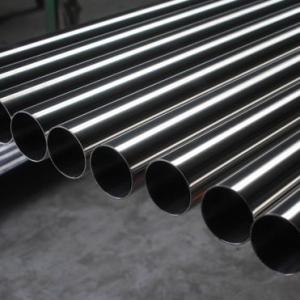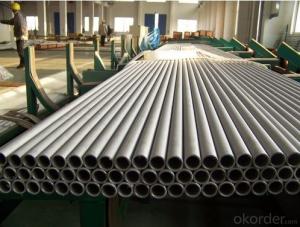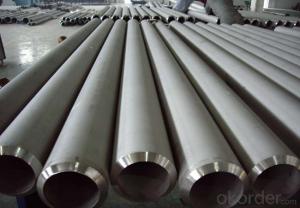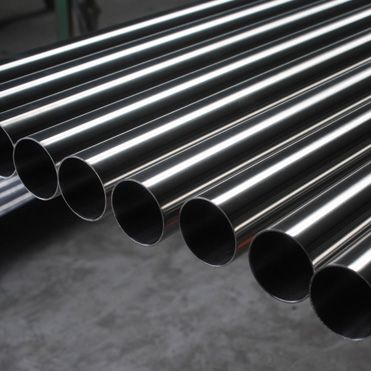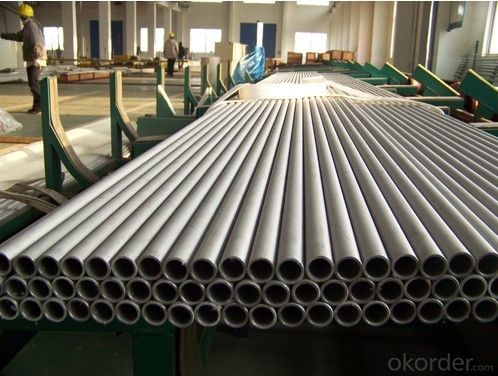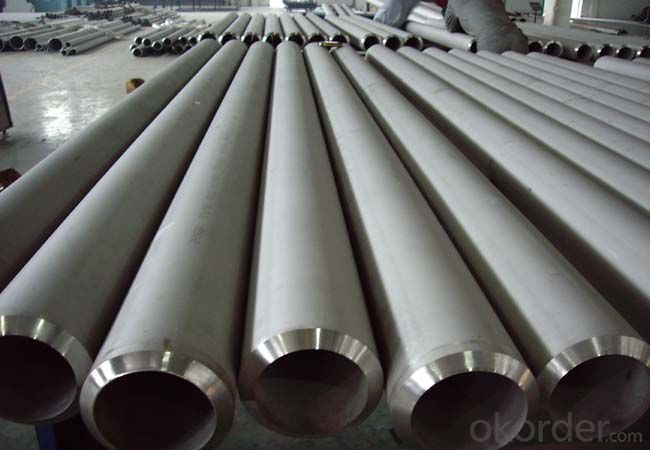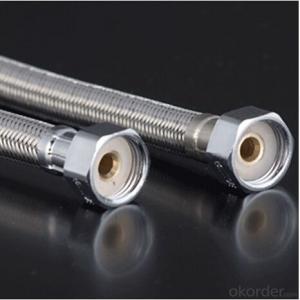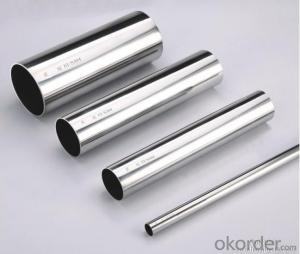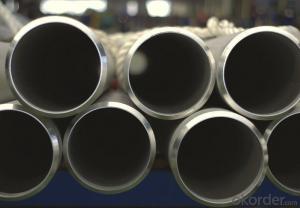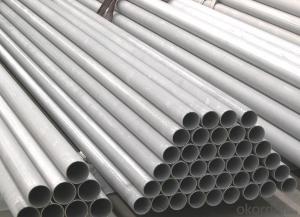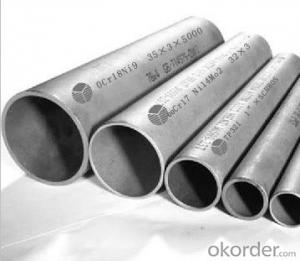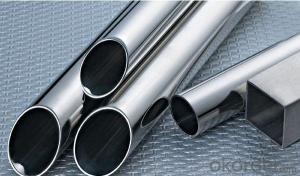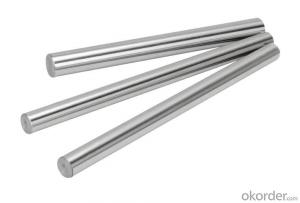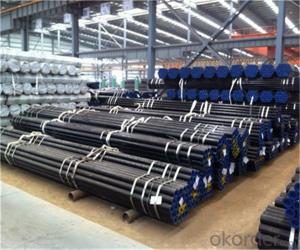Austenitic Seamless Steel Pipe Good Corrosion Resistance 304(0Cr18Ni9)
- Loading Port:
- Ningbo
- Payment Terms:
- TT OR LC
- Min Order Qty:
- 1 m.t.
- Supply Capability:
- 5000 m.t./month
OKorder Service Pledge
OKorder Financial Service
You Might Also Like
1、Structure of seamless steel pipe 304 Description:
A large amount of Seamless Steel Pipes 304 are offered to the clients at cost effective rates. These pipes are extremely durable, resistant to corrosion and have high tensile strength. Our pipes are used in nuclear plants, power plants, refineries and construction industry across the country. Furthermore, we are capable of providing these seamless pipes to the clients in bulk quantity.
2、Main Features of the seamless steel pipe 304:
• High manufacturing accuracy
• High strength
• Small inertia resistance
• Strong heat dissipation ability
• Good visual effect
•Reasonable price
3、seamless steel pipe 304 images:
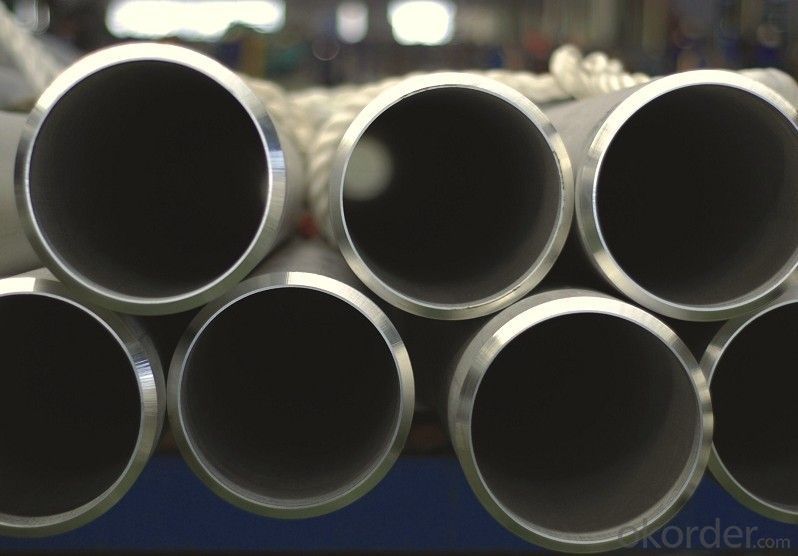

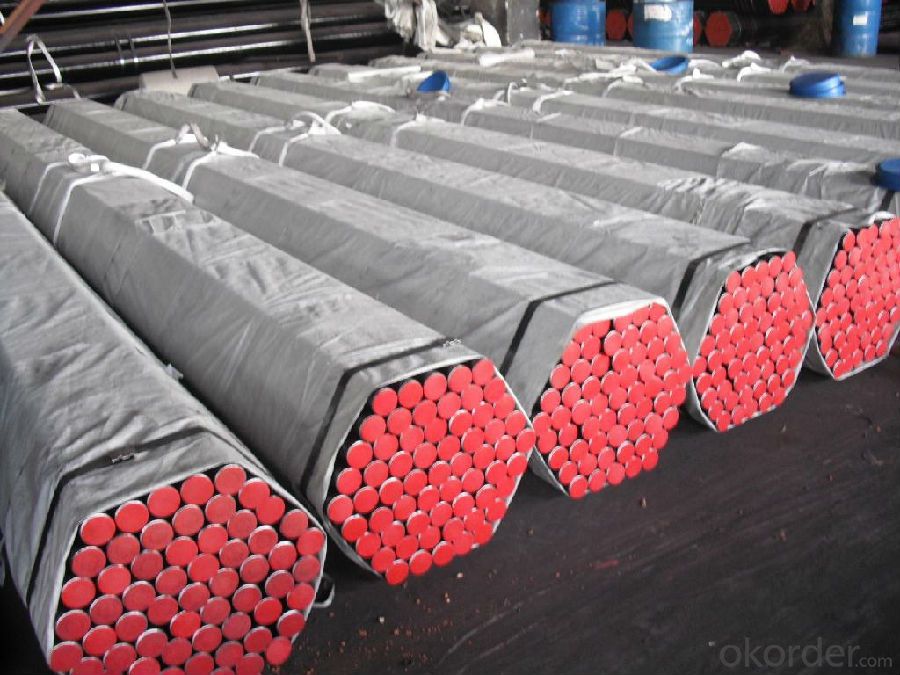
4、seamless steel pipe 304 Specification:
1.Type:seamless
2.Standard:ASTM
3.Material Grand:304 stainless steel
4.Size:OD8-1000MM*WT0.5-80MM
Standard: | JIS, AISI, ASTM, GB, DIN, EN | Place of Origin: | Zhejiang China (Mainland) | Brand Name: | SR |
Type: | Seamless | Steel Grade: | 300 Series | Certification: | ISO |
Thickness: | 0.8mm--22mm | Outer Diameter: | 20mm--800mm | process: | Cold drawn,cold roll |
product: | seamless pipe/tube,elbow,tee,reducer | MOQ: | 1000kg | standard: | A312/A213/A269/A249/A358/A268/A789/ |
Packaging & Delivery
Packaging Detail: | Standard seaworthy package(wooden boxes package,pvc package, and other package) |
Delivery Detail: | 5-30 days after confirmation of prepayment depending on quantity |
Tolerance | a) Outer Diameter: +/- 0.2mm b) Thickness: +/- 0.02mm c) Length: +/- 5mm |
Surface | 180G, 320G, 400G Satin / Hairline 400G, 500G, 600G or 800G Mirror finish and so on. |
Specification | ASTM A213,ASTM A312,ASTM A269,ASTM A778,ASTM A790,DIN 17456,DIN 17458,JIS G3459,JIS G3463 etc |
Material | TP304,TP304L,TP304H,TP304/304L,TP316,TP316L,TP316/316L,TP310,TP317, TP317L,TP321,TP321H,TP347,TP347H,S31803,S32205(Duplex),904L etc |
Application range | Stainless steel pipe applies to construction field, ships building industry, petroleum & chemicalindustries, war and electricity industries,food processing and medical industry, boiler heat exchanger,machinery andhardware fields. Stainless steel pipe can be made accordingto the customers requirements. |
Delivery conditions | Annealed, pickled & polished. |
Note | We can produce other standard as the customers’ requirement. |
5、FAQ of seamless steel pipe 304:
①How is the quality of your products?
Our products are manufactured strictly according to national and internaional standard, and we take a test
on every pipe before delivered out. If you want see our quality certifications and all kinds of testing report, please just ask us for it.
Guaranteed: If products’ quality don’t accord to discription as we give or the promise before you place order, we promise 100% refund.
②How about price?
Yes, we are factory and be able to give you lowest price below market one, and we have a policy that “ for saving time and absolutely honest business attitude, we quote as lowest as possible for any customer, and discount can be given according to quantity”,if you like bargain and factory price is not low enough as you think, just don’t waste your time.Please trust the quotation we would give you, it is professional one.
③Why should you chose us?
Chose happens because of quality, then price, We can give you both.Additionally, we can also offer professional products inquiry, products knowledge train(for agents), smooth goods delivery, exellent customer solution proposals.Our service formula: good quality+good price+good service=customer’s trust
SGS test is available, customer inspection before shipping is welcome, third party inspection is no problem.
Any question, pls feel free to contact us !
- Q: What's the difference between stainless steel 302 and 304?
- [difference] 302 stainless steel and 304 stainless steel 304 stainless steel is one of the most widely used kind of chromium - nickel stainless steel, as a widely used steel, corrosion resistance, good heat resistance, low temperature strength and mechanical properties; punching, bending and other thermal processing, non hardening heat treatment (using temperature -196 to 800 DEG C). 302 stainless steel the carbon is relatively high (302 C = 0.15%; 304 C is less than or equal to 0.08%) and better strength. The other indicators are basically the same as those of 304.
- Q: Can stainless steel pipes be used for geothermal applications?
- Yes, stainless steel pipes can be used for geothermal applications. Stainless steel is a durable and corrosion-resistant material that can withstand the harsh conditions and high temperatures associated with geothermal systems. It is particularly suitable for geothermal applications due to its resistance to corrosion caused by the presence of minerals and chemicals in the geothermal fluid. Stainless steel pipes also have excellent heat transfer properties, which is essential for efficient heat exchange in geothermal systems. Additionally, stainless steel pipes have a long lifespan and require minimal maintenance, making them a reliable choice for geothermal applications.
- Q: Can stainless steel pipes be used for architectural purposes?
- Yes, stainless steel pipes can be used for architectural purposes. Stainless steel is highly durable, corrosion-resistant, and aesthetically appealing, making it an ideal material for architectural projects such as building facades, handrails, staircases, and decorative fixtures. Its versatility and modern appearance make it a popular choice for both indoor and outdoor architectural designs.
- Q: What is the difference between 904L and 2205 stainless steel pipes?
- 904L and 2205 are both types of stainless steel pipes, but they have some key differences. Firstly, the composition of the two steels is different. 904L stainless steel is a high alloy austenitic stainless steel that contains high levels of chromium, nickel, and molybdenum. It also has low carbon content, making it highly resistant to corrosion and pitting. On the other hand, 2205 stainless steel is a duplex stainless steel that consists of a mixture of austenite and ferrite phases. It contains lower levels of chromium and nickel compared to 904L, but has higher levels of molybdenum and nitrogen. Secondly, the mechanical properties of the two steels differ. 904L stainless steel has excellent toughness and high strength, making it suitable for applications in aggressive environments such as chemical processing plants and offshore oil and gas platforms. In contrast, 2205 stainless steel has good overall mechanical properties, with high tensile and yield strength. It is commonly used in industries such as marine, paper, and pulp, where resistance to stress corrosion cracking is important. Another difference lies in their resistance to corrosion. While both steels are corrosion-resistant, 904L stainless steel has exceptional resistance to a wide range of corrosive environments, including sulfuric acid, hydrochloric acid, and saltwater. This makes it ideal for use in industries where extreme corrosion resistance is required. 2205 stainless steel, although not as corrosion-resistant as 904L, still offers good resistance to many corrosive substances, making it suitable for various applications. Cost is another factor that sets these steels apart. Due to its high alloy content and superior properties, 904L stainless steel is generally more expensive than 2205 stainless steel. Therefore, the choice between the two will depend on the specific requirements of the application and the budget. In summary, the main differences between 904L and 2205 stainless steel pipes lie in their composition, mechanical properties, corrosion resistance, and cost. Understanding these distinctions will help in selecting the appropriate stainless steel pipe for a given application.
- Q: Are stainless steel pipes resistant to intergranular corrosion?
- Yes, stainless steel pipes are resistant to intergranular corrosion. Stainless steel contains a high amount of chromium, which forms a passive oxide layer on the surface of the metal. This oxide layer acts as a protective barrier, preventing the penetration of corrosive agents and inhibiting the occurrence of intergranular corrosion. Additionally, stainless steel pipes are often alloyed with elements such as molybdenum or titanium, which further enhance their resistance to intergranular corrosion. However, it is important to note that the resistance to intergranular corrosion may vary depending on the specific grade of stainless steel and the environmental conditions in which the pipes are exposed.
- Q: What is the average weight of a stainless steel pipe?
- The average weight of a stainless steel pipe can vary depending on its size, wall thickness, and length. Stainless steel pipes are available in different dimensions and grades, which can affect their weight. However, in general, stainless steel pipes tend to be heavier than pipes made from other materials due to the density of stainless steel. On average, a stainless steel pipe can weigh anywhere from a few kilograms to several hundred kilograms per meter, depending on the aforementioned factors. It is important to consult specific product specifications or consult with a supplier to determine the precise weight of a stainless steel pipe for a particular application.
- Q: What are the common industry standards for stainless steel pipes?
- The common industry standards for stainless steel pipes include ASTM A312/A312M for seamless and welded pipes, ASTM A269 for seamless and welded tubes, and ASME B36.19M for stainless steel pipe dimensions. These standards ensure the quality, dimensions, and performance of stainless steel pipes in various applications.
- Q: What is the typical wall thickness of stainless steel pipes?
- The typical wall thickness of stainless steel pipes can vary depending on the specific application and industry requirements. However, it is common to find stainless steel pipes with wall thickness ranging from 0.065 inches (1.65 mm) to 0.250 inches (6.35 mm).
- Q: Are stainless steel pipes suitable for brewery fermentation tanks?
- Yes, stainless steel pipes are highly suitable for brewery fermentation tanks. Stainless steel is corrosion-resistant, easy to clean, and has excellent hygienic properties. It does not react with the beer, ensuring the quality and taste of the final product. Additionally, stainless steel pipes maintain temperature control and provide durability, making them a popular choice in the brewing industry.
- Q: Can stainless steel pipes be insulated with polycarbonate?
- Insulating stainless steel pipes with polycarbonate is not possible. Polycarbonate is a thermoplastic material known for its transparency, impact resistance, and insulation capabilities. While it can insulate some pipes like PVC or copper, it is not suitable for stainless steel pipes. These pipes are typically used in high-temperature or corrosive environments, necessitating insulation materials that can withstand such conditions. It is advisable to opt for insulation materials specifically designed for stainless steel pipes, such as mineral wool, fiberglass, or foam pipe insulation.
Send your message to us
Austenitic Seamless Steel Pipe Good Corrosion Resistance 304(0Cr18Ni9)
- Loading Port:
- Ningbo
- Payment Terms:
- TT OR LC
- Min Order Qty:
- 1 m.t.
- Supply Capability:
- 5000 m.t./month
OKorder Service Pledge
OKorder Financial Service
Similar products
Hot products
Hot Searches
Related keywords
